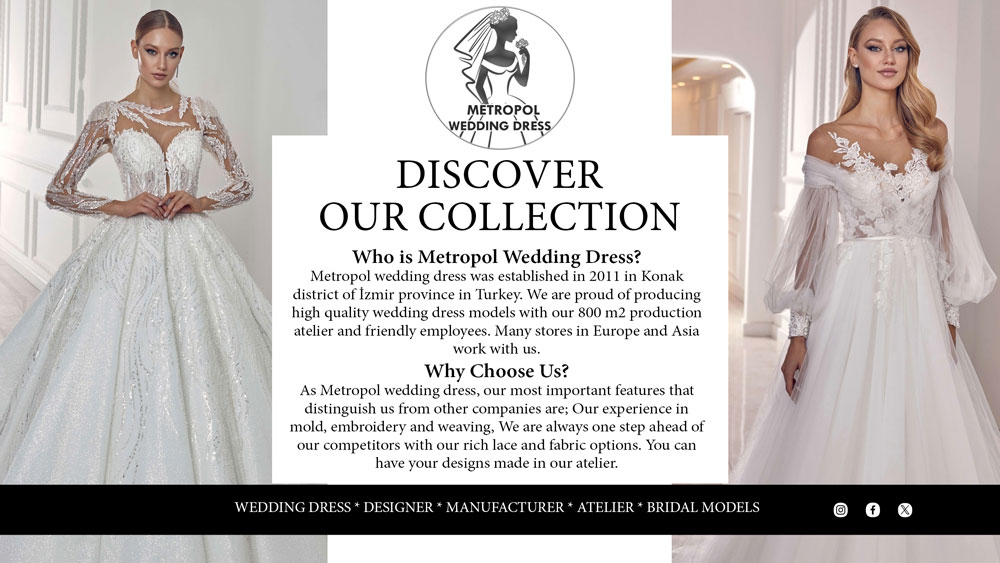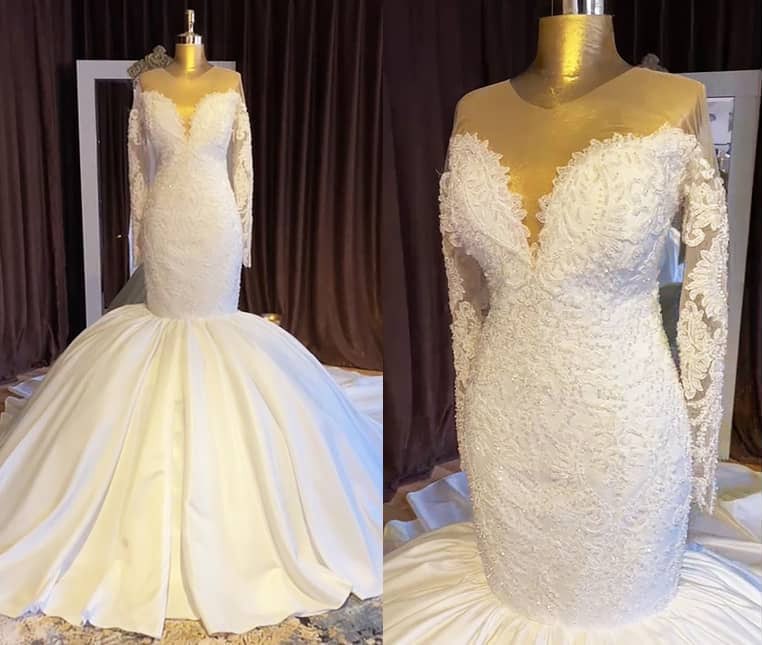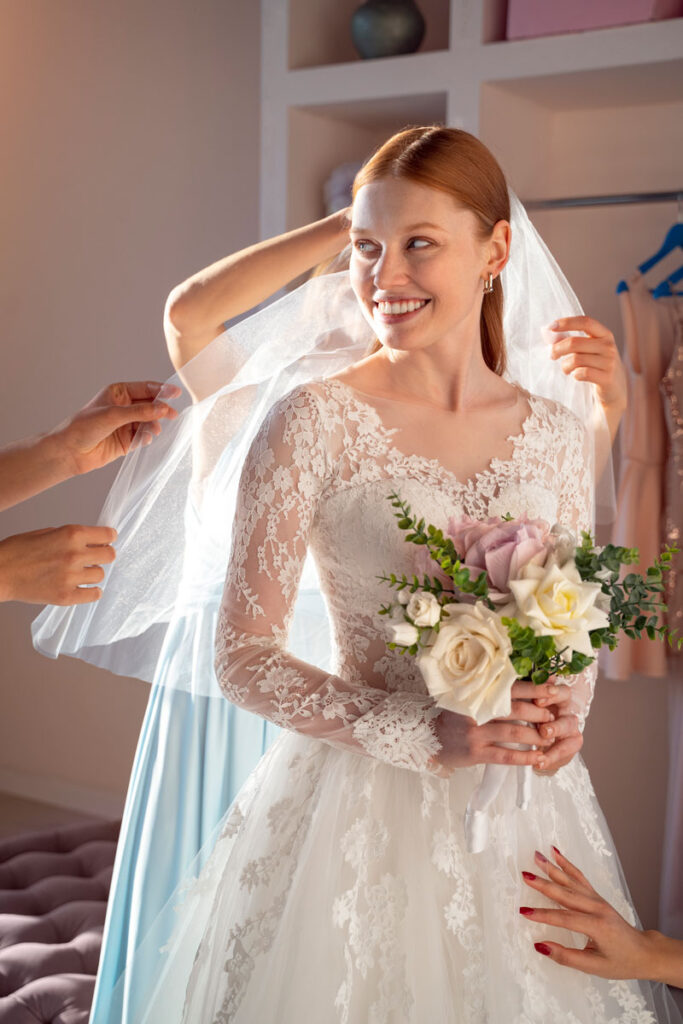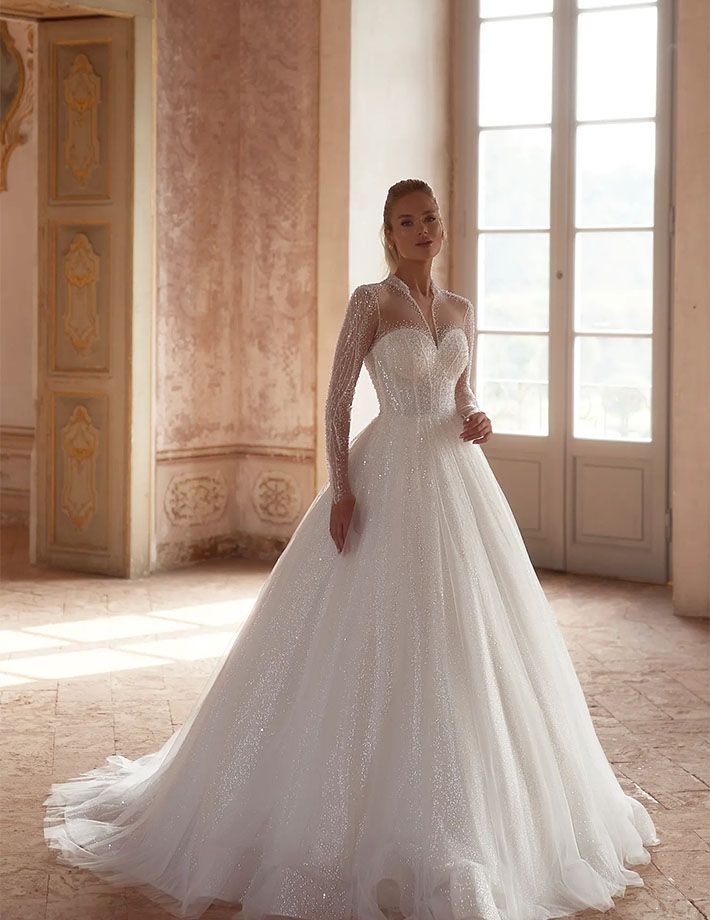
Turkish Wedding Dress With Hijab Best 5 What does a Muslim bride wear A Muslim bride typically wears a wedding dress that adheres to the principles of Islamic modesty, known as “hijab” or “jilbab”. The specific attire can vary based on cultural traditions and personal preferences, but it often includes the following elements:
Wedding Dress: The bride may wear a gown that is modest yet elegant, often with long sleeves and a full-length skirt. The dress may be white or any other color preferred by the bride.
Hijab or Headscarf: A headscarf is commonly worn to cover the hair and neck. This could be a simple scarf or a more elaborate headpiece depending on regional customs and the bride’s style.
Veil: Some brides choose to wear a veil that covers their face before the ceremony. This is often lifted by the groom during the wedding proceedings.
Jewelry: Accessories such as earrings, necklaces, and bracelets are worn, though they are typically modest in design and not overly flashy.
Shoes: Shoes are generally chosen to complement the wedding dress and are often covered by the gown.
Makeup: Makeup is applied modestly, enhancing natural features without being too extravagant.
Cultural Variations: Depending on the bride’s cultural background, there may be additional elements such as henna designs on the hands and feet, traditional embroidery, or specific fabrics that hold cultural significance.
Overall, the attire of a Muslim bride combines traditional elements of modesty with individual style and cultural influences, creating a beautiful and meaningful ensemble for the wedding day.
Turkish Wedding Dress With Hijab
What is the dress code for a Muslim wedding
The dress code for a Muslim wedding can vary based on cultural traditions, regional customs, and personal preferences of the bride, groom, and their families. Here are some general guidelines that are commonly observed:
For Men:
Men typically wear traditional attire such as a thobe (long robe) or a sherwani (long coat) paired with trousers.
Some cultures may prefer men to wear a suit or formal attire, especially in Western countries.
It is customary for men to dress modestly and avoid overly casual clothing.
For Women:
Women usually wear modest clothing that covers their body appropriately according to Islamic guidelines. This often includes dresses or gowns that are long-sleeved and ankle-length.
Many Muslim brides opt for a wedding dress that includes a hijab (headscarf) or a headpiece that covers their hair, in accordance with Islamic modesty standards.
The dress can vary in color and design based on cultural preferences and personal style.
It is common for women to wear elegant and modest jewelry and accessories that complement their attire.
General Guidelines:
Modesty is key, with both men and women dressing in a manner that respects Islamic principles.
Bright and festive colors are often preferred, but the choice of color can also be influenced by cultural traditions.
Guests attending the wedding are also expected to dress modestly, avoiding revealing or flashy attire.
Cultural Variations:
Different cultures within the Muslim world have their own unique traditions and dress codes. For example, in South Asian Muslim weddings (like Pakistani or Indian), women may wear heavily embellished outfits with intricate embroidery and jewelry, while in Arab weddings, women may wear more understated yet elegant attire.
Traditional clothing and customs from the bride and groom’s respective cultural backgrounds may also influence the overall dress code.
Overall, while there are general guidelines for attire at a Muslim wedding, the specifics can vary widely depending on regional customs and personal choices. The emphasis is typically on modesty, elegance, and respecting Islamic values. Turkish Wedding Dress With Hijab
When can a woman take off her hijab
The decision for a Muslim woman to take off her hijab (headscarf) can vary based on personal, cultural, and religious factors. Here are some common situations when a woman might choose to remove her hijab:
In Private Settings: Many Muslim women feel comfortable removing their hijab in the privacy of their own home, among close family members, or in women-only spaces where they feel safe and respected.
During Sleep: It is common practice for Muslim women to remove their hijab while sleeping or resting, similar to how people of other cultures might remove hats or head coverings for comfort.
When Performing Ritual Purification (Wudu): Before performing the Islamic ablution (wudu) for prayer, women may remove their hijab to wash their face, hands, and other required body parts.
During Medical Examinations: In medical settings, women may need to remove their hijab for examinations or treatments, especially when necessary for medical procedures.
Personal Choice: Some women may choose to remove their hijab temporarily or permanently due to personal reasons, such as feeling more comfortable in certain environments, career requirements, or changes in beliefs.
In Certain Non-Muslim Majority Countries: In countries where there are no legal or societal requirements to wear the hijab, some Muslim women may decide not to wear it in public for personal reasons or as a form of personal expression.
It’s important to note that the decision to wear or remove the hijab is deeply personal and influenced by individual interpretations of religious teachings, cultural norms, and personal convictions. In Islam, modesty is highly valued, and many women choose to wear the hijab as a symbol of their faith and identity. However, the specific circumstances under which a woman may choose to remove her hijab can vary widely based on individual circumstances and interpretations.
wedding dress turkey online shop
Sure, if you’re looking for online shops in Turkey where you can buy wedding dresses, here are a few popular options:
- Modanisa – Known for a wide range of modest fashion including wedding dresses.
- Website: Modanisa
- Pronovias – Offers a selection of elegant wedding dresses and bridal accessories.
- Website: Pronovias
- Vakko Wedding – Vakko is a well-known Turkish brand that offers wedding dresses and bridal collections.
- Website: Vakko Wedding
- Lidyana – Features a variety of wedding dresses and bridal fashion.
- Website: Lidyana
- Markafoni – An online platform offering various fashion items, including wedding dresses.
- Website: Markafoni
Before making a purchase, ensure to check shipping policies, return options, and customer reviews to ensure a smooth shopping experience.
Do Muslim brides wear a veil
Yes, Muslim brides often wear a veil as part of their wedding attire, although this practice can vary depending on cultural and personal preferences. The veil worn by Muslim brides serves a symbolic and often ceremonial purpose during the wedding proceedings. Here are some common aspects related to the veil worn by Muslim brides:
Niqab or Face Veil: In some cultures and traditions, the bride may wear a niqab, which is a face veil that covers the entire face except for the eyes. This is usually lifted by the groom during the wedding ceremony or after the marriage contract (nikah) is signed.
Wedding Veil: Similar to Western bridal traditions, Muslim brides may wear a wedding veil that covers their head and sometimes extends over their shoulders or back. This veil is often worn along with a headscarf (hijab) and is part of the overall wedding attire.
Cultural Variations: The style and length of the veil can vary based on cultural practices and personal preferences. For example, in some cultures, the bride may wear a heavily embellished veil or one that matches the intricacy of her wedding dress.
Symbolism: The veil worn by the bride symbolizes modesty, purity, and the sanctity of the marriage union. It is also a marker of the bride’s transition into a new phase of life.
Post-Wedding: After the wedding ceremony, the bride may choose to continue wearing a veil or remove it depending on personal and cultural considerations.
Overall, while the practice of wearing a veil varies among Muslim communities and individual brides, it remains a significant and cherished part of many Muslim wedding traditions, symbolizing beauty, modesty, and the bride’s commitment to her marriage. Turkish Wedding Dress With Hijab
turkish wedding dress, traditional
Traditional Turkish wedding dresses are typically rich in cultural symbolism and often feature intricate designs and craftsmanship. Here are some key characteristics and elements you might find in traditional Turkish wedding dresses:
- Materials and Fabrics: Traditional Turkish wedding dresses often feature luxurious fabrics such as silk, satin, velvet, or brocade. These fabrics are chosen for their richness and ability to showcase intricate embroidery and embellishments.
- Embroidery and Detailing: Turkish wedding dresses are known for their elaborate embroidery, which often includes motifs inspired by Ottoman art, floral patterns, and geometric designs. Gold or silver thread embroidery is common, adding a touch of luxury and elegance.
- Colors: While white has become popular for modern Turkish weddings due to Western influence, traditional Turkish wedding dresses historically featured vibrant colors such as red, green, or purple. These colors symbolize joy, celebration, and prosperity.
- Design Elements: Traditional dresses may feature elements such as a fitted bodice, voluminous skirts, and long sleeves. The neckline can vary from modest to more revealing styles, depending on the region and cultural influences.
- Accessories: Traditional Turkish bridal attire is often accompanied by accessories such as a headpiece (usually a decorative veil or a traditional embroidered scarf called “yazma”), jewelry (like gold coins or necklaces), and elaborate footwear.
- Regional Variations: Different regions of Turkey have their own unique styles and variations of wedding attire. For example, the “bindalli” is a traditional dress style from the Ottoman period, characterized by its long flowing sleeves and rich embroidery.
If you’re interested in purchasing a traditional Turkish wedding dress, you might consider looking at specialized boutiques or online platforms that cater to cultural and traditional attire. It’s also helpful to research specific regional styles if you have a particular aesthetic in mind.

What color do Muslim brides wear
The color that Muslim brides wear can vary widely depending on cultural traditions, regional customs, and personal preferences. While white is a popular choice in many Western weddings, it is not universally adopted in Muslim wedding ceremonies. Here are some common colors and their symbolic meanings in different Muslim cultures:
Red: Red is a traditional color for brides in many Muslim cultures, especially in South Asia (such as Pakistan, India, Bangladesh) and parts of the Middle East. It symbolizes prosperity, joy, and good luck.
Gold: Gold is often used in conjunction with other colors or as a main color for bridal attire. It symbolizes wealth, luxury, and celebration.
White: While less common historically, white has become increasingly popular for Muslim brides, influenced by Western bridal trends. It symbolizes purity, innocence, and new beginnings.
Pastel Colors: Soft pastel shades such as pink, peach, lavender, and mint green are also popular choices for Muslim brides, particularly in modern and fusion weddings. These colors often represent femininity, grace, and elegance.
Bold Colors: In some cultures, brides opt for bold and vibrant colors such as royal blue, emerald green, or deep purple. These colors can symbolize strength, passion, and cultural heritage.
Regional and Cultural Influences: The specific color choice can vary significantly based on regional customs and cultural practices. For example, Moroccan brides may wear intricate kaftans in rich colors and patterns, while Turkish brides might prefer shades of crimson and gold.
Ultimately, the color of the bridal attire for Muslim weddings is a matter of personal and cultural preference. It often reflects cultural heritage, family traditions, and the bride’s individual style while adhering to principles of modesty and elegance.
turkish wedding dress male
Traditional Turkish wedding attire for men is known for its elegance and cultural significance. Here are some key features and elements of traditional Turkish wedding dress for men:
- Suits (Frak): One of the most common traditional outfits for Turkish grooms is the “frak,” which is a formal suit often worn in ceremonies and special occasions. The frak typically includes a long black coat with tails, paired with trousers and a white dress shirt.
- Vests (Ceket): Another traditional element of Turkish wedding attire for men is the vest, known as “ceket.” This can be worn over a shirt and paired with trousers. Vests can vary in style and may be embroidered or embellished depending on the region and cultural influences.
- Headwear (Fes or Turban): Traditional headwear includes the “fes,” a cylindrical felt hat usually in black or red, adorned with a tassel. Alternatively, some regions may opt for a turban-style headwear, especially in more ceremonial settings.
- Accessories: Accessories play a significant role in completing the traditional Turkish groom’s attire. This can include a decorative waistband (kuşak), often in gold or silver thread embroidery, as well as footwear such as leather shoes.
- Regional Variations: Different regions of Turkey may have variations in their traditional wedding attire for men. For instance, in some areas, the groom may wear a different style of coat or vest, or the headwear may vary in design and color.
- Modern Influences: While traditional attire is still cherished, modern Turkish weddings may see grooms opting for Western-style suits or a blend of traditional and contemporary elements, depending on personal preference and the style of the wedding.
If you’re interested in purchasing or exploring traditional Turkish wedding attire for men, it’s advisable to visit specialized boutiques that cater to cultural and ceremonial clothing. Additionally, online platforms that focus on traditional Turkish attire may offer a range of options to suit different preferences and styles.
Do you have to convert to marry a Muslim
In Islam, marriage between a Muslim and a non-Muslim is permissible under certain conditions, though the specifics can vary based on interpretations within different Islamic schools of thought and cultural traditions. Here are some key points to consider regarding marriage between a Muslim and a non-Muslim:
Muslim Requirements:
According to Islamic law (Sharia), a Muslim man is permitted to marry a woman from the People of the Book (Ahl al-Kitab), which includes Christians and Jews. This is based on the belief in shared Abrahamic origins and a recognition of their monotheistic faiths.
However, Muslim women are generally advised to marry Muslim men to avoid potential complications regarding religious upbringing of children and the practice of Islam within the household.
Conversion:
Some Muslim scholars and communities require that a non-Muslim spouse convert to Islam before the marriage can take place. This requirement is based on the interpretation that marriage is a religious contract and should ideally be between two Muslims to ensure compatibility in faith and practice.
In many cases, the conversion process involves a declaration of faith (Shahada) in front of witnesses and acceptance of the basic principles of Islam.
Interpretations and Cultural Practices:
The requirement for conversion before marriage can vary widely based on cultural practices and the interpretation of Islamic teachings by local religious authorities and families.
In some cases, couples may choose to proceed with a civil marriage ceremony recognized by legal authorities, even if the religious requirements for marriage in Islam are not met.
Practical Considerations:
Before entering into a marriage with a Muslim partner, it’s important for both individuals to discuss and understand the religious and cultural expectations, as well as any legal requirements in their respective countries.
Couples may also need to consider how they will navigate differences in religious practice and upbringing of children, if applicable.
In summary, while conversion to Islam is often encouraged or required in some Muslim communities before marriage to a Muslim, the practice and requirements can vary significantly based on cultural and religious contexts. It’s advisable for couples to seek guidance from local religious authorities and have open discussions about their beliefs and expectations before making decisions about marriage.
What to wear to a Muslim wedding as a non-Muslim
Attending a Muslim wedding as a non-Muslim offers an opportunity to show respect for Islamic traditions and cultural practices while also expressing your personal style. Here are some guidelines on what to wear:
Modesty: Modesty is key when selecting attire for a Muslim wedding. This means opting for clothing that covers the shoulders, arms, and legs. Avoid outfits that are revealing or overly tight.
Women’s Attire:
Dresses or Skirts: A knee-length or longer dress or skirt paired with a modest blouse or top is appropriate. Maxi dresses are also a good choice.
Sleeves: Opt for sleeves that cover at least the upper arms. If your dress is sleeveless or has short sleeves, consider wearing a lightweight cardigan or shawl.
Neckline: Choose a dress or top with a modest neckline that does not show cleavage.
Head Covering: While not typically required for non-Muslim women, some choose to wear a headscarf (hijab) out of respect. This is optional and depends on personal preference and cultural context.
Men’s Attire:
Formal Wear: A suit or dress pants paired with a button-down shirt and tie is appropriate.
Traditional Attire: Depending on the cultural context of the wedding, men may also wear traditional clothing such as a thobe (long robe) or sherwani (long coat).
Footwear: Choose formal or semi-formal shoes that are comfortable for standing and walking, as weddings typically involve ceremonies and receptions.
Colors: While there’s no strict color code, it’s best to avoid wearing white (as it can compete with the bride’s attire) and overly flashy colors. Opt for rich, subdued, or vibrant colors depending on personal preference and the formality of the event.
Respect Cultural Customs: Familiarize yourself with any specific cultural customs or traditions associated with the wedding you’re attending. This shows respect for the hosts and their cultural background.
Accessories: Keep accessories elegant and modest. Avoid overly extravagant jewelry or accessories that may detract from the occasion.
By dressing modestly and respectfully, you’ll not only adhere to Islamic etiquette but also contribute to the celebratory atmosphere of the wedding. If you have any doubts about what to wear, don’t hesitate to ask the hosts or a close friend of the bride or groom for guidance. Turkish Wedding Dress With Hijab
turkish wedding dress price
The price of a Turkish wedding dress can vary widely depending on several factors, including the style, material, craftsmanship, and brand. Here are some general guidelines:
What to bring to a Muslim wedding
Attending a Muslim wedding is an opportunity to celebrate a joyous occasion and show respect for Islamic traditions. Here are some thoughtful items you might consider bringing:
Gift:
Bringing a gift for the newlyweds is customary. It can range from monetary gifts (often placed in an envelope or a special box) to household items or items that the couple has registered for.
Common gifts include kitchen appliances, home decor items, or personalized gifts that reflect the couple’s tastes and preferences.
If unsure about what to give, cash or gift cards are also appreciated as they allow the couple to choose what they need.
Appropriate Attire:
As discussed earlier, dressing modestly and appropriately for the occasion is crucial. Ensure your attire respects Islamic traditions and is suitable for a formal or semi-formal wedding setting.
Respectful Behavior:
Showing respect for Islamic customs and traditions by being polite, considerate, and observing any religious practices or ceremonies that may occur during the wedding.
Following any guidelines provided by the hosts regarding seating arrangements, prayer times, or other cultural customs.
Personal Hygiene Items:
Depending on the venue and cultural practices, it may be thoughtful to bring personal hygiene items such as tissues, hand sanitizer, or a small hand towel.
Camera or Smartphone:
To capture moments of joy and celebration, bring a camera or smartphone to take photos (if permitted). Be respectful of the couple’s wishes regarding photography during certain parts of the ceremony.
Warm Wishes:
Bringing a warm and genuine smile along with your good wishes for the couple’s future happiness and prosperity is always appreciated.
Understanding Cultural Differences:
If you are not familiar with Muslim wedding customs, it might be helpful to familiarize yourself with them beforehand or ask questions respectfully during the event.
By bringing a thoughtful gift, dressing appropriately, and respecting cultural customs, you will contribute to the joyous atmosphere of the wedding and show appreciation for the couple’s special day.
Why do Muslim brides wear henna
Muslim brides, particularly in many Middle Eastern, South Asian, and North African cultures, wear henna (also known as mehndi) for several cultural and symbolic reasons:
Cultural Tradition: The application of henna on a bride’s hands and feet is a long-standing cultural tradition in many Muslim-majority countries. It is often considered an integral part of pre-wedding ceremonies and celebrations.
Symbol of Celebration: Henna symbolizes joy, beauty, and spiritual awakening. Its application is seen as a way to celebrate and adorn the bride for her special day.
Blessings and Protection: In some cultures, it is believed that henna brings blessings, luck, and protection to the bride. It is also thought to ward off evil spirits and bring prosperity to the couple.
Community and Festivity: Applying henna is a social event where family members and friends gather to celebrate the upcoming wedding. It creates a festive atmosphere and strengthens bonds within the community.
Personal Expression: The intricate designs of henna allow the bride to express her individual style and creativity. The patterns often include motifs that hold personal or cultural significance.
Transition to Marriage: The process of applying henna marks a symbolic transition for the bride from her single life to becoming a married woman. It is considered an auspicious and joyous occasion.
Healing Properties: Henna paste is known for its natural cooling properties and is believed to have a calming effect, which can be beneficial for the bride during the wedding festivities.
Overall, the tradition of applying henna to Muslim brides is a cultural practice deeply rooted in symbolism, community celebration, and the joyous anticipation of marriage.
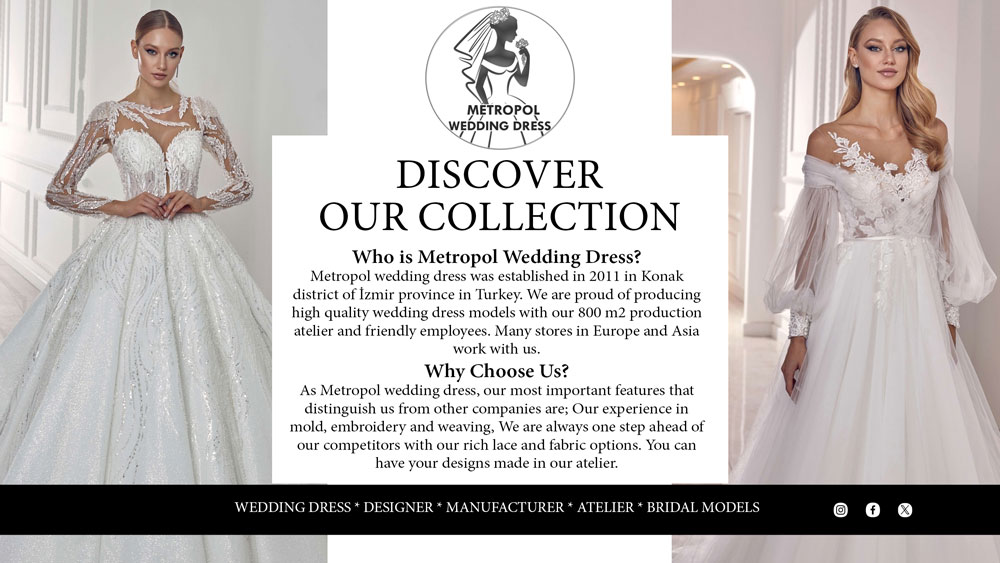
turkish wedding dress white
Traditional Turkish wedding dresses in white have become more popular in recent years, influenced by Western bridal trends. Here are some features and considerations for a white Turkish wedding dress:
- Design: White Turkish wedding dresses often blend traditional Turkish elements with contemporary bridal fashion. They can feature elements such as intricate embroidery, beadwork, lace accents, and floral motifs, reflecting both cultural heritage and modern elegance.
- Materials: Common fabrics used for white Turkish wedding dresses include silk, satin, chiffon, and lace. These fabrics are chosen for their ability to drape beautifully and showcase delicate embellishments.
- Silhouette: The silhouette of a white Turkish wedding dress can vary from fitted mermaid styles to flowing A-line or ball gown shapes. Necklines can range from modest high necks to plunging V-necks or off-the-shoulder styles, depending on personal preference and cultural norms.
- Accessories: Accessories play a crucial role in completing the bridal look. Traditional Turkish bridal accessories may include a decorative veil or headpiece, jewelry such as gold coins or earrings, and embellished footwear.
- Cost: Like any wedding dress, the price of a white Turkish wedding dress can vary widely depending on factors such as the designer, materials used, craftsmanship, and whether it’s custom-made or off-the-rack. Prices can range from a few hundred dollars to several thousand dollars or more for couture designs.
- Shopping: To find a white Turkish wedding dress, consider visiting bridal boutiques specializing in Turkish or Middle Eastern bridal wear. Online platforms that offer international shipping may also have a selection of white Turkish wedding dresses.
When shopping for a white Turkish wedding dress, it’s essential to consider your personal style, cultural preferences, and budget to find the perfect dress for your special day.
Why do Muslim brides cover their face
The practice of Muslim brides covering their face, particularly during the wedding ceremony, is rooted in cultural and religious traditions prevalent in certain Muslim communities. Here are some reasons why Muslim brides may choose to cover their face:
Modesty: Modesty is a fundamental principle in Islam, and covering the face is seen as a way to maintain modesty and privacy, especially in the presence of unrelated men. This practice aligns with the broader Islamic concept of hijab, which encourages both men and women to dress and behave modestly.
Cultural Tradition: In some cultures, covering the bride’s face with a veil or a face veil (niqab) is a customary practice during the wedding ceremony. This tradition may be influenced by local customs and cultural norms rather than strict religious requirements.
Symbolism: The veil or face covering worn by the bride can symbolize purity, humility, and the bride’s respect for Islamic teachings on modesty. It is often considered a mark of reverence for the solemnity and sanctity of the marriage ceremony. Turkish Wedding Dress With Hijab
Respect for Elders: In certain families or communities, elders may encourage or expect the bride to cover her face as a sign of respect for tradition and cultural heritage.
Personal Choice: While some Muslim brides choose to cover their face during the wedding ceremony as a matter of personal or familial tradition, others may opt not to, depending on their interpretation of Islamic teachings and personal preferences.
It’s important to note that the practice of covering the face varies widely across different Muslim cultures and communities. It is not universally practiced or required in Islam, and views on whether it is necessary or appropriate can differ among scholars and individuals. As with many aspects of Islamic practice, the decision to cover the face during a wedding ceremony is often influenced by cultural customs, personal beliefs, and family traditions.
Can I wear a black wedding dress in Islam
In Islam, there is no specific religious prohibition against wearing a black wedding dress. The choice of wedding attire, including the color of the dress, is generally guided by cultural traditions, personal preferences, and local customs rather than strict religious requirements. Here are some considerations regarding wearing a black wedding dress in the context of Muslim weddings:
Cultural Context: In many Muslim cultures and regions, white or other vibrant colors are traditionally preferred for wedding dresses, symbolizing purity, joy, and celebration. However, cultural practices can vary widely, and some brides may opt for colors that hold personal significance or align with modern fashion trends.
Modesty: Regardless of the color chosen, it is important for the wedding dress to adhere to principles of modesty as prescribed in Islam. This typically means ensuring the dress covers the body appropriately, is not tight-fitting, and does not reveal the shape of the body.
Personal Choice: Ultimately, the choice of a wedding dress color, including black, is a personal decision made by the bride and groom, taking into account their cultural background, individual preferences, and any family traditions.
Symbolism: In some cultures, black may symbolize elegance, sophistication, or be chosen for its classic appeal. It may also have personal significance to the bride and groom, such as aligning with a specific theme or aesthetic for their wedding.
Respect for Traditions: If considering wearing a black wedding dress, especially in a cultural context where it is less common, it’s advisable to communicate openly with family members and the wedding party to ensure that the choice is respected and understood.
In summary, while black wedding dresses are not traditionally common in many Muslim cultures, there is no religious prohibition against wearing them. The decision ultimately depends on the bride’s personal preferences, cultural background, and mutual agreement with the groom, taking into consideration the overall atmosphere and traditions of the wedding ceremony.
turkish wedding dress guest
When attending a Turkish wedding as a guest, it’s essential to dress appropriately and respect cultural norms while also reflecting your personal style. Here are some tips for choosing a suitable outfit for a Turkish wedding as a guest:
- Formality: Turkish weddings can range from casual to formal depending on the venue and hosts’ preferences. It’s wise to ask the hosts or check the invitation for any dress code guidelines. Typically, weddings tend to be more formal events, so aim for elegant attire.
- Color: Avoid wearing white or anything that might resemble the bride’s attire, as it is considered disrespectful in many cultures, including Turkish weddings. Instead, opt for vibrant colors or muted tones like pastels, which are generally well-received.
- Women’s Attire: Women can choose to wear a dress or a skirt with a blouse. The style can vary from cocktail dresses to more formal evening gowns, depending on the formality of the event. Modest dressing is appreciated, so avoid overly revealing outfits.
- Men’s Attire: Men typically wear suits or dress shirts with trousers. A tie or bow tie is often worn for a more formal touch. Traditional Turkish attire like a “frak” (formal suit with tails) is less common among guests but could be worn if the wedding is particularly formal or traditional.
- Accessories: Enhance your outfit with appropriate accessories such as jewelry, handbags, and shoes that complement your attire and the occasion’s formality.
- Comfort: Ensure that your outfit is comfortable for sitting, standing, and dancing, as weddings often involve various activities throughout the day or evening.
- Cultural Sensitivity: While Turkish weddings may incorporate Western fashion influences, respecting cultural norms is important. Conservative and respectful attire is generally appreciated.
By following these guidelines, you can choose an outfit that aligns with Turkish wedding customs while expressing your personal style as a guest. If in doubt, feel free to ask the hosts for advice on attire expectations.
Can I wear an abaya to a wedding
Wearing an abaya to a wedding would typically depend on the cultural context and the specific customs of the community you are attending the wedding in. Here are some considerations:
Cultural Norms: In some Muslim cultures, particularly in conservative communities or regions, wearing an abaya (a loose-fitting robe-like garment) may be considered appropriate attire for women at weddings. It is modest and aligns with Islamic principles of covering the body.
Formality of the Wedding: Consider the formality of the wedding and the dress code specified by the hosts. While an abaya is modest, some weddings may have specific expectations regarding attire, such as formal dresses or traditional cultural attire.
Respect for the Occasion: Attending a wedding is a joyous occasion and showing respect for the hosts, traditions, and cultural norms is important. If you choose to wear an abaya, ensure it is clean, well-presented, and suitable for the celebratory atmosphere of a wedding.
Alternative Options: If you prefer not to wear an abaya but still wish to dress modestly, consider wearing a formal dress or outfit that adheres to Islamic principles of modesty, such as a long dress or skirt paired with a modest blouse or top.
Communicate with the Hosts: If you are unsure about the dress code or cultural expectations, it’s helpful to communicate with the hosts or a trusted friend or family member who can provide guidance on appropriate attire for the wedding. Turkish Wedding Dress With Hijab
Ultimately, the appropriateness of wearing an abaya to a wedding depends on the specific customs and expectations of the community hosting the wedding. By respecting local traditions and dressing modestly, you can participate in the celebration while adhering to Islamic principles of dress and conduct.
Do you wear anything under an abaya
Yes, typically women wear clothing under an abaya for modesty and comfort. What is worn underneath can vary based on personal preference, cultural norms, and weather conditions. Common garments worn under an abaya include:
Inner Clothing:
Long Sleeves and Pants: Women often wear long-sleeved tops and loose-fitting pants or leggings underneath the abaya to ensure modesty and coverage of their arms and legs.
Long Tunic or Dress: Some may opt for a long tunic or dress that covers the body appropriately, especially if the abaya is semi-transparent or made of lighter fabric.
Modest Undergarments: Depending on personal preference and comfort, modest undergarments are worn beneath the inner clothing.
Footwear:
Shoes or sandals are worn under the abaya. The type of footwear can vary based on the occasion and cultural customs.
Accessories:
Depending on cultural and personal preferences, women may wear accessories such as a headscarf (hijab), jewelry, and a belt to accessorize their outfit while maintaining modesty.
The choice of clothing underneath the abaya aims to adhere to Islamic principles of modesty and cultural norms. It also ensures that the attire is practical and comfortable for daily activities while maintaining a modest appearance in public settings. Turkish Wedding Dress With Hijab
Is it OK not to wear abaya
Whether or not it’s considered okay not to wear an abaya (a loose-fitting outer garment worn by some Muslim women) depends on various factors including cultural norms, religious interpretations, and personal choice. Here are some points to consider:
Cultural Norms: In some conservative Muslim-majority countries and communities, wearing an abaya is considered a customary and expected form of dress for women in public settings. Deviating from this norm may attract attention or criticism.
Religious Interpretations: From a religious standpoint, Islam emphasizes modesty in attire for both men and women. The specific requirements for modest dress vary among different interpretations and schools of thought within Islam. Some interpretations emphasize covering the entire body including loose-fitting clothing that covers arms and legs, while others may focus more on general modesty without specifying specific garments like the abaya.
Personal Choice: In many countries and communities, Muslim women have the freedom to choose their attire based on personal preference, cultural background, and individual interpretation of religious teachings. Some may choose to wear alternative forms of modest dress such as long dresses, skirts, or loose-fitting pants paired with modest tops that cover the body appropriately.
Local Laws and Customs: It’s important to be aware of and respect local laws and customs regarding dress code, especially when visiting or residing in countries where certain forms of attire are mandated by law or societal expectations.
Context and Situation: The appropriateness of not wearing an abaya can also depend on the specific context and situation. For example, attire considered acceptable at home or among close family may differ from what is considered appropriate in public spaces or formal gatherings.
Ultimately, whether it is okay not to wear an abaya is a personal decision influenced by a variety of factors including cultural norms, religious beliefs, personal comfort, and local customs. It’s important to be mindful of these factors and to make choices that align with personal values and respect for local customs and traditions.
What age should you start wearing abaya
The decision to start wearing an abaya, a loose-fitting outer garment worn by some Muslim women for modesty, can vary depending on cultural and personal factors. Here are some considerations regarding the age at which a girl or woman might start wearing an abaya:
Puberty: In many Muslim cultures and families, the decision to start wearing an abaya is often tied to reaching puberty or adolescence. This milestone signifies the beginning of adulthood and the onset of religious responsibilities, including modesty in dress.
Cultural and Family Norms: The age at which girls begin wearing an abaya can be influenced by cultural traditions and family customs. Some families may encourage or expect girls to start wearing modest clothing, including an abaya, from a young age to instill values of modesty and piety.
Individual Choice and Readiness: Ultimately, the decision to wear an abaya should be a matter of personal choice and readiness. Some girls may feel comfortable and ready to adopt wearing an abaya at a younger age, while others may prefer to wait until they are older or until it aligns with their personal beliefs and understanding of modesty. Turkish Wedding Dress With Hijab
Local Laws and Customs: In countries where certain forms of attire are mandated by law or societal expectations, the age at which girls begin wearing an abaya may be influenced by legal requirements or community norms.
Guidance from Parents and Religious Leaders: Parents and religious leaders often play a role in guiding young girls on matters of religious practice and modesty. They may provide advice and support in making decisions about when to start wearing an abaya based on religious teachings and cultural considerations.
Ultimately, the age at which a girl starts wearing an abaya can vary widely based on individual circumstances, cultural traditions, and personal beliefs. It’s important for families to approach this decision with sensitivity and consideration for the girl’s readiness and understanding of modesty in Islam.


